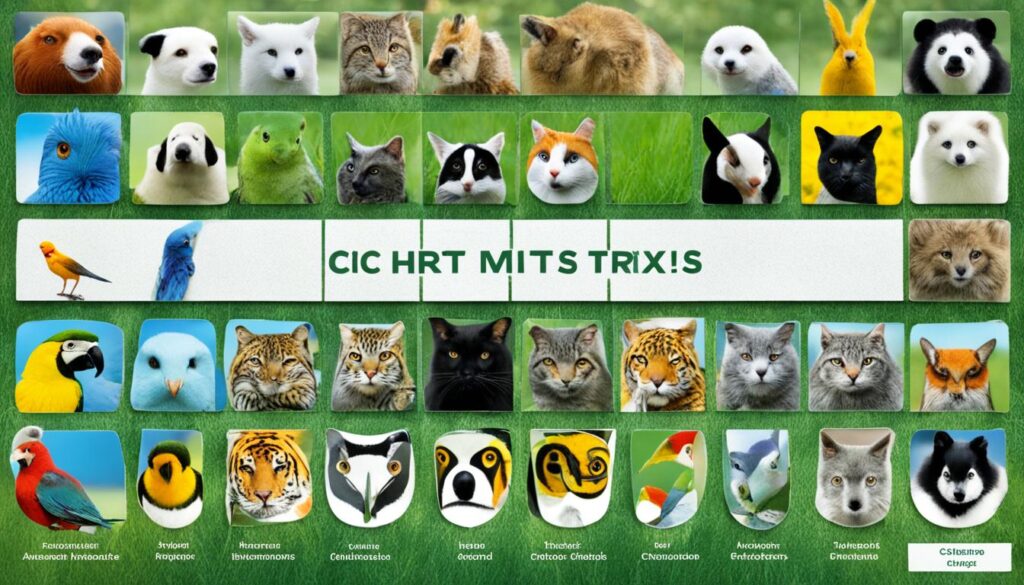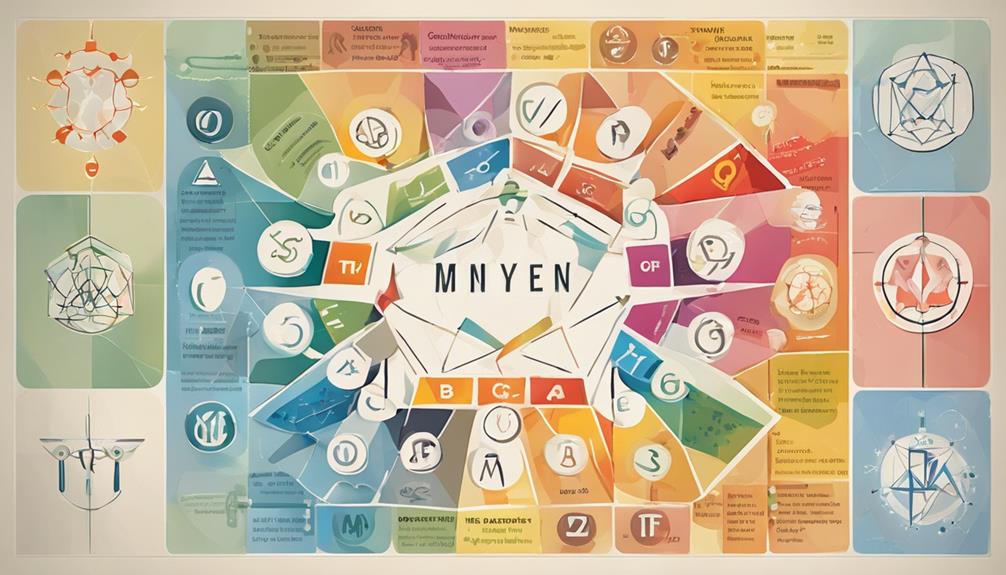Are you aware that a thorough comprehension of animal behavior can be attained through a DISC assessment? Indeed, it’s true! The identical tool utilized to pinpoint personality types in humans can also be utilized with animals. By employing the DISC model, pet owners and trainers can acquire valuable insights into their animal’s behavior, communication styles, and personality traits. This facilitates improved communication, training, and overall well-being for our animal companions.
Key Takeaways:
- A DISC assessment can be used to analyze and understand animal behavior.
- It helps identify an animal’s communication style and personality traits.
- Understanding an animal’s DISC profile can enhance training and interaction.
- Tailoring communication to an animal’s DISC style improves the human-animal relationship.
- Using DISC assessment leads to improved animal welfare and overall well-being.
The DiSC Circular Model
The DiSC Assessment is based on a circular model that represents four distinct personality types: Dominance (D), Influence (I), Steadiness (S), and Compliance (C).
Each type has its own characteristics and communication preferences, allowing for a comprehensive understanding of animal behavior and personality traits.
Animal behavior profiling and personality profiling can help pet owners and trainers effectively communicate and interact with animals.
Dominance (D)
People with a dominant personality type are focused on achieving results and taking action quickly. In animals, this may manifest as assertiveness, dominance in social hierarchies, and a desire for control.
Influence (I)
Individuals with an influence personality type are outgoing, enthusiastic, and enjoy socializing. In animals, this may be evident in their friendliness, sociability, and ability to inspire collaboration among other animals or humans.
Steadiness (S)
Those with a steadiness personality type value stability, harmony, and providing support to others. In animals, this may be reflected in their calm and nurturing nature.
Compliance (C)
People with a compliance personality type prioritize accuracy, attention to detail, and maintaining stability. In animals, this may be observed in their meticulous behavior, preference for routine, and analytical approach to problem-solving.
Animal Personality Profiling
By applying the DiSC Assessment to animal behavior, pet owners and trainers can tailor their approach to meet the unique needs of individual animals. Understanding an animal’s personality type can guide communication and training strategies, leading to improved relationships and overall animal welfare.
| Personality Type | Characteristics | Communication Preferences |
|---|---|---|
| Dominance (D) | Assertive, results-oriented, desires control | Direct and concise |
| Influence (I) | Outgoing, enthusiastic, enjoys socializing | Upbeat and positive |
| Steadiness (S) | Calm, nurturing, values stability | Patience, empathy, support |
| Compliance (C) | Accurate, detail-oriented, analytical | Clear, concise, logical explanations |
Understanding the “D” Style
The “D” style, or Dominance style, is characterized by individuals who are focused on achieving results and taking action quickly. In animals, this style may manifest as assertiveness, dominance in social hierarchies, and a desire for control. Understanding the “D” style can help pet owners and trainers adapt their communication to appeal to animals with this personality type. Direct and concise communication is often preferred by animals with a dominant style.

Animals with a dominant personality type thrive in environments where they can assert their dominance and take charge. They are natural leaders and strive to be in control of their surroundings. This can be seen in their interactions with other animals and humans. Dominant animals often exhibit confident body language and assertive behaviors.
When communicating with animals of the “D” style, it is important to establish yourself as a capable leader. They respond well to direct and authoritative communication. Use firm and clear commands to convey your expectations. Avoid using hesitant or ambiguous language, as it may be interpreted as a sign of weakness.
Key Characteristics of the “D” Style:
- Dominance: Animals with the “D” style possess a natural desire for control and assertiveness.
- Direct Communication: They respond best to clear and concise communication that leaves no room for interpretation.
- Assertiveness: These animals are not afraid to assert their dominance and take charge of their environment.
By understanding the “D” style and adapting our communication strategies, we can establish a strong and respectful relationship with animals of this personality type. This allows for effective training, successful behavior modification, and a harmonious interaction between humans and animals.
Understanding the needs and preferences of dominant animals is crucial for maintaining a healthy and balanced relationship. By aligning our communication style with their dominant personality, we can build trust and respect, paving the way for a fulfilling human-animal connection.
| Communication Tips for the “D” Style | Examples |
|---|---|
| Be direct and assertive in your commands. | “Sit!” |
| Use confident body language to convey your leadership. | Stand tall, maintain eye contact. |
| Establish clear boundaries and expectations. | Consistently enforce rules and limits. |
Exploring the “I” Personality Type
When it comes to understanding animal behavior, the “I” personality type, also known as the Influence style, plays a crucial role. This personality type is associated with individuals who are outgoing, enthusiastic, and enjoy socializing. Just like humans, animals can exhibit this personality type, and it’s important to recognize their characteristics in order to effectively communicate with them.
Animals with an “I” personality type are known for their friendliness, sociability, and ability to inspire collaboration among other animals or humans. They thrive on positive interactions and enthusiastic communication. By engaging with animals of the “I” style in an upbeat and positive manner, we can establish a strong connection and create a harmonious relationship.
Enthusiastic communication is key when interacting with animals of the “I” personality type. Using engaging language, expressing genuine interest, and maintaining an upbeat tone can captivate their attention and foster trust and cooperation. By showing excitement and enthusiasm in our interactions, we are more likely to receive a positive response from animals with an “I” style.
The Power of Enthusiastic Communication
Enthusiastic communication is a powerful tool in our interactions with animals. When we exude positivity and energy, animals are more likely to respond positively and engage with us. This type of communication stimulates their curiosity and encourages them to participate in activities or training sessions.
“Using enthusiastic communication is like lighting a spark in the hearts of animals. It ignites their natural curiosity and encourages them to explore new possibilities.” – Animal Behavior Expert
Through enthusiastic communication, we can motivate animals to showcase their natural talents and abilities. This not only helps us understand their unique personalities better but also enables us to build a deeper connection based on trust, respect, and mutual understanding.
Effective Communication Strategies for the “I” Personality Type
When interacting with animals of the “I” personality type, it’s essential to employ effective communication strategies that cater to their enthusiastic nature. Here are some key strategies to consider:
- Use positive reinforcement techniques such as rewards, treats, or praise to motivate and incentivize animals.
- Engage in interactive play sessions to stimulate their curiosity and provide opportunities for socialization.
- Encourage animals to express themselves by creating an environment that fosters self-expression and exploration.
- Utilize visual aids or toys that capture their attention and encourage their participation.
By applying these strategies and adapting our communication style to match the “I” personality type, we can create an environment that nurtures their sociability and enthusiasm, ultimately strengthening the bond between humans and animals.

The influence of enthusiastic communication on animals with an “I” personality type cannot be overstated. It is a powerful tool that allows us to connect with them on a deeper level and foster a positive relationship based on trust and collaboration.
Uncovering the “S” DiSC Personality Type
The “S” personality type, also known as the Steadiness style, is characterized by individuals who value stability, harmony, and providing support to others. This personality type is reflected in the behavior of animals known to possess an “S” personality type, as they often exhibit a calm and nurturing nature.
Animals with an “S” personality type appreciate patience, empathy, and a supportive communication style. To effectively interact with animals of this type, it is important to build a sense of trust and maintain a stable environment. By creating a space of security and establishing a strong connection, individuals can foster a deeper understanding and build a positive relationship with animals of the “S” personality type.
“Animals with an ‘S’ personality type appreciate patience, empathy, and a supportive communication style.”
This personality type is often found in animals such as therapy animals, who excel in providing comfort and support to individuals in need. Their calm and nurturing nature makes them ideal companions for those seeking solace. Additionally, animals with an “S” personality type can serve as valuable partners in tasks that require a steady and reliable presence.
Understanding the “S” personality type in animals can be further enhanced through the use of an animal personality test such as the DISC Assessment. This test helps individuals uncover their animal’s unique personality traits, enabling a deeper understanding of their needs and preferences.

Image: An image depicting the peaceful and harmonious nature of animals with an “S” personality type.
Examining the “C” Personality Type
In this section, we will delve into the “C” personality type, also known as the Conscientiousness style, and its relevance in understanding animal behavior. As with humans, animals with a “C” personality type exhibit characteristics of prioritizing accuracy, attention to detail, and maintaining stability.
Animals with a “C” personality type are often observed displaying meticulous behavior, showing a preference for routine, and showcasing an analytical approach to problem-solving. They thrive in structured environments and value order and consistency.
To effectively communicate with animals of the “C” style, clarity and conciseness are key. Providing logical explanations and offering a systematic and organized approach to interaction and learning are highly appreciated. By acknowledging their need for accuracy and attention to detail, we can establish a strong foundation for effective communication with these animals.
Understanding the “C” personality type in animals is valuable as it helps us tailor our communication and approach to their specific needs. By recognizing their meticulous nature, we can create an environment that fosters their desire for stability and precision.

Benefits of Understanding the “C” Personality Type in Animals
By addressing the unique communication requirements of animals with a “C” personality type, we can enhance their overall well-being and create a harmonious environment. Some of the benefits of recognizing and adapting to their conscientiousness style include:
- Promoting a sense of security and stability in their surroundings
- Facilitating effective problem-solving and decision-making processes
- Cultivating a deeper sense of trust and cooperation between humans and animals
- Minimizing stress and anxiety by providing clear expectations and routines
By respecting and accommodating the needs of animals with a “C” personality type, we can establish a positive and fulfilling relationship that promotes their overall well-being and contentment.
Now that we have explored the characteristics of the “C” personality type in animals and the benefits of understanding and adapting to their needs, let’s continue to the next section where we will discuss the application of DiSC assessment to animal behavior analysis and assessment.
Applying DiSC Assessment to Animal Behavior
The DiSC Assessment provides valuable insights into animal behavior, allowing us to evaluate their temperament, communication style, and overall needs. By applying the DiSC model to animals, we can gain a deeper understanding of their unique personalities and tailor our approach to training, behavior modification, and care.
Through the assessment, we identify an animal’s DiSC personality type, which enables us to adapt our strategies and techniques accordingly. This assessment goes beyond surface-level observations and provides a comprehensive analysis of how animals interact with their environment and other animals.
One of the key benefits of applying the DiSC Assessment to animal behavior is its ability to enhance communication between humans and animals. By understanding an animal’s communication style, we can adjust our interactions to better connect with them, leading to more effective communication and a stronger bond.
The DiSC Assessment also enables us to evaluate an animal’s temperament, which is crucial for understanding their needs and preferences. We can gain insights into their behavioral patterns, tendencies, and responses to different stimuli, allowing us to create a more conducive and enriching environment for them.
Additionally, the assessment allows us to identify an animal’s communication preferences, whether they prefer direct and assertive communication or a more nurturing and supportive approach. By aligning our communication style with theirs, we can strengthen the human-animal relationship and foster a deeper level of trust and understanding.
Here’s an example of how the DiSC Assessment can be applied to animal behavior:
| DiSC Personality Type | Behavioral Traits | Communication Style |
|---|---|---|
| Dominance (D) | Assertive, dominant in social hierarchies, desires control | Responds well to direct and concise communication |
| Influence (I) | Outgoing, sociable, inspires collaboration | Prefers upbeat and positive communication |
| Steadiness (S) | Calm, nurturing, values stability | Appreciates patience, empathy, and a supportive style |
| Conscientiousness (C) | Meticulous, prefers routine, analytical problem-solving | Responds well to clear, concise, and logical explanations |
By using the DiSC Assessment to analyze animal behavior, we can unlock a deeper understanding of their needs, preferences, and communication styles. This knowledge empowers us to adapt our approach to training, behavior modification, and overall care, leading to more effective communication, problem-solving, and a stronger bond between humans and animals.

The Benefits of Using DiSC Assessment for Animal Training
Integrating the DiSC Assessment into animal training can offer numerous benefits for both pet owners and animal trainers. By understanding an animal’s personality type, trainers can adapt their methods to suit the individual needs and learning styles of each animal. This allows for more effective training sessions and better overall results. Additionally, pet owners can gain valuable insights into their animal’s behavior and communication preferences, enhancing their relationship and strengthening the bond with their pet.
Improved Training Effectiveness
With DiSC Assessment, trainers can tailor their approach based on the animal’s personality type, ensuring that the training methods align with their natural behaviors and motivations. This targeted approach can optimize the training process and accelerate learning, leading to faster progress and improved training effectiveness. By recognizing the unique communication styles of different animals, trainers can develop customized strategies to effectively convey expectations and reinforce desired behaviors.
Enhanced Understanding and Connection
Using DiSC Assessment, pet owners can gain a deeper understanding of their animal’s behavior and communication preferences. This insight allows them to adjust their interactions and meet their pet’s needs more effectively. By aligning their communication style with the animal’s preferences, pet owners can establish stronger bonds and nurture a harmonious relationship based on trust and mutual understanding. This deeper connection can lead to a happier, healthier, and more fulfilling companionship.
Optimized Problem Solving
DiSC Assessment equips trainers and pet owners with valuable insights into the animal’s problem-solving approach. By understanding their animal’s decision-making process and problem-solving strategies, individuals can provide the necessary guidance and support, enabling the animal to overcome challenges more efficiently. This enhanced problem-solving ability can reduce frustration and stress for both animals and their caregivers, creating a more positive and productive learning environment.
Informed Decision Making
By utilizing DiSC Assessment, trainers and pet owners can make more informed decisions regarding training techniques, enrichment activities, and overall care. Understanding an animal’s personality type allows individuals to tailor their approach to meet their specific needs, preventing unnecessary stress and promoting overall well-being. Informed decision-making based on the animal’s personality assessment ensures that the chosen strategies and interventions align with their natural tendencies, optimizing their learning experience and overall quality of life.
Stronger Human-Animal Relationship
Integrating DiSC Assessment into animal training fosters a stronger and more harmonious bond between humans and animals. By gaining insights into the animal’s personality type, individuals can adapt their communication and behavior to meet their needs and preferences. This creates a positive and supportive environment for the animal, enhancing their trust in their human caregivers and promoting a mutually beneficial relationship. This strengthened connection enriches the lives of both humans and animals, leading to a happier and more fulfilling companionship.
| Benefits of DiSC Assessment for Animal Training |
|---|
| Improved training effectiveness by tailoring methods to the animal’s personality type |
| Enhanced understanding and connection between pet owners and animals |
| Optimized problem solving through insights into the animal’s decision-making process |
| Informed decision making for training techniques and overall care |
| Stronger human-animal relationship based on mutual understanding and adapted communication |

Enhancing Animal Communication with DiSC Assessment
Effective communication is vital in building a strong bond between humans and animals. By leveraging the power of DiSC Assessment, we can gain a deeper understanding of animal communication styles and enhance our ability to connect with them. Recognizing an animal’s unique communication style allows us to adjust our own approach, leading to improved understanding and a more harmonious relationship.
Animals, much like humans, have distinct communication preferences. Some may be direct and assertive, while others may be more nurturing and supportive. DiSC Assessment enables us to identify these styles and tailor our communication accordingly, creating a bridge of understanding between species.
Through DiSC Assessment, we can bridge the communication gap between humans and animals, fostering empathy, reducing conflicts, and building a stronger connection.
When dealing with animals who have a direct and assertive communication style, it is important to be clear and concise in our interactions. They respond well to straightforward commands and appreciate a confident approach.
On the other hand, animals with a more nurturing and supportive communication style require a different approach. They respond positively to gentle tones and empathetic gestures, seeking reassurance and care.
By adapting our communication style based on the animal’s preference, we create an environment of trust and understanding. This paves the way for effective communication, reducing conflicts and allowing us to work together towards shared goals.
Let us now explore a table that highlights the different animal communication styles and corresponding DiSC profiles:
| Animal Communication Style | DiSC Profile |
|---|---|
| Direct and assertive | Dominance (D) |
| Nurturing and supportive | Steadiness (S) |
Understanding these communication styles and their associated DiSC profiles empowers us to cater to the unique needs of each animal. By adjusting our approach, we create a more harmonious and effective communication channel, deepening our connection with animals.
Now, let’s take a moment to visualize the different animal communication styles with this impactful image: 
With this newfound knowledge of animal communication styles, we can establish stronger connections with our furry friends. DiSC Assessment opens doors to a world of effective communication, empathy, and mutual understanding.
Continue reading to explore how the DiSC Assessment can transform our understanding of animal behavior and lead to improved animal welfare.
The Transformation Through DiSC Assessment
The application of DiSC Assessment to animal behavior analysis and profiling can lead to a transformative understanding of animals’ needs and preferences. By utilizing this assessment tool, we can develop a deeper appreciation for the complexities of animal behavior and communication.
This understanding can lead to more effective training, better relationships between humans and animals, and overall improved animal welfare.

Understanding animal behavior through DiSC Assessment allows us to uncover valuable insights into an animal’s unique personality and communication style.
“DiSC Assessment has revolutionized the way we approach animal training and behavior analysis. It has allowed us to gain a deeper understanding of our animals’ needs and preferences, enabling us to provide targeted and effective interventions.”
By employing disc animal behavior analysis techniques, we can tailor our training methods to best suit each animal based on their individual personality traits. This personalized approach improves our ability to communicate and connect with animals, leading to a more harmonious and productive relationship.
Enhanced Training and Communication
DiSC Assessment provides a framework for enhancing animal training by enabling us to:
- Identify specific communication styles that resonate with each animal.
- Adjust training approaches to suit the individual learning preferences of animals.
- Develop personalized strategies for addressing behavioral challenges.
With these insights, we can effectively address behavioral issues and build stronger bonds with animals, resulting in more successful training outcomes.
Improved Animal Welfare
By understanding animal behavior on a deeper level, we can make informed decisions that prioritize the welfare and well-being of animals.
“DiSC Assessment has given us a greater appreciation for the emotional and cognitive needs of animals. This understanding has allowed us to create more enriching environments and tailor our interactions to meet the unique needs of each individual animal.”
By applying animal behavioral profiling and disc animal behavior analysis, we can tailor our care and management strategies to support animals’ optimal physical and emotional health. This commitment to their well-being contributes to an improved quality of life for animals under our care.
Conclusion
In conclusion, the DISC Assessment offers a valuable framework for understanding animal behavior and communication. By utilizing this assessment tool, we can identify an animal’s personality type and tailor our approach to training, communication, and overall care. This leads to improved relationships, enhanced performance, and reduced conflicts in the human-animal dynamic.
Applying the DISC model in the context of animal behavior analysis and assessment allows us to gain a deeper understanding and appreciation of animals and their unique personalities. Identifying an animal’s disc profile helps inform our interactions and enables us to meet their specific needs and preferences.
Whether it’s understanding a dominant animal’s need for direct communication, nurturing an animal with a steady personality type, engaging an animal with an influencing personality, or providing logical explanations for an analytical animal, the disc assessment for pet behavior equips us with the insights we need to build effective and harmonious relationships with our animal companions.
By harnessing the power of the DISC Assessment for animal personality, we can deepen our bond with animals, enhance their well-being, and create more fulfilling and rewarding experiences for both them and us.
FAQ
How can the DiSC Assessment be applied to animals?
The DiSC Assessment can be applied to animals to gain a deeper understanding of their behavior and communication styles. By using the DiSC model, individuals can adapt their communication to improve relationships with animals.
What are the four personality types in the DiSC Circular Model?
The four personality types in the DiSC Circular Model are Dominance (D), Influence (I), Steadiness (S), and Compliance (C).
How can the “D” style be recognized in animals?
The “D” style in animals is characterized by assertiveness, dominance in social hierarchies, and a desire for control.
How can the “I” personality type be identified in animals?
The “I” personality type in animals is associated with friendliness, sociability, and the ability to inspire collaboration.
What are the traits of the “S” personality type in animals?
Animals with an “S” personality type exhibit calm and nurturing behavior, valuing stability and providing support to others.
How can the “C” personality type be observed in animals?
Animals with a “C” personality type demonstrate meticulous behavior, a preference for routine, and an analytical approach to problem-solving.
How can the DiSC Assessment be applied to animal behavior?
The DiSC Assessment can help evaluate an animal’s behavior, temperament, and communication style to better understand their needs and preferences.
What are the benefits of using the DiSC Assessment for animal training?
The DiSC Assessment allows trainers to adapt their methods to suit the individual needs and learning styles of animals, leading to more effective training sessions.
How can DiSC Assessment enhance communication between humans and animals?
DiSC Assessment can help individuals recognize an animal’s communication style and adjust their own communication to better connect with the animal, reducing conflicts and improving understanding.
How can DiSC Assessment transform our understanding of animal behavior?
DiSC Assessment provides a framework for understanding animals’ needs and preferences, improving training, relationships, and overall animal welfare.









